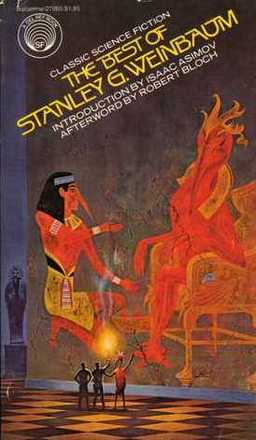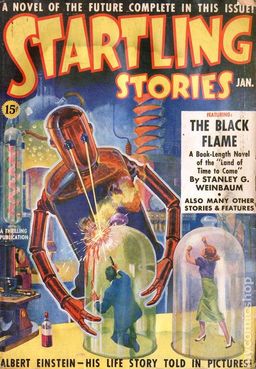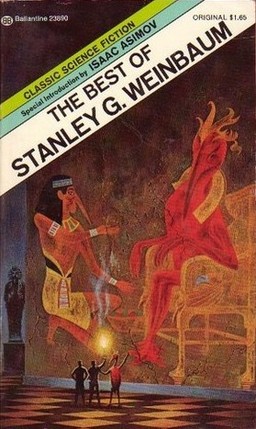Vintage Treasures: The Best of Stanley G. Weinbaum
 This is the fifth volume in Lester Del Rey’s Classics of Science Fiction line I’ve discussed here (starting with The Best of Murray Leinster, The Best of Robert Bloch, The Best of Henry Kuttner, and The Best of C M Kornbluth.) I believe it may also have been the first, since it has the earliest publication date of the titles we’ve examined so far — April 1974 — and also because the cover design for the first printing (see below) was slightly different and a little rougher.
This is the fifth volume in Lester Del Rey’s Classics of Science Fiction line I’ve discussed here (starting with The Best of Murray Leinster, The Best of Robert Bloch, The Best of Henry Kuttner, and The Best of C M Kornbluth.) I believe it may also have been the first, since it has the earliest publication date of the titles we’ve examined so far — April 1974 — and also because the cover design for the first printing (see below) was slightly different and a little rougher.
And also because, if you’re going to launch a series dedicated to the very best science fiction and fantasy writers of the century, it makes sense to start with Stanley G. Weinbaum.
This isn’t the first time we’ve covered Weinbaum’s career. The distinguished Ryan Harvey wrote a terrific retrospective three years ago, where he said, in part:
In a way, Weinbaum was science fiction’s equivalent of Robert E. Howard: a hugely talented author who died too young. But Weinbaum’s run was even shorter than Howard’s — a mere year and a half, with twelve stories published during that time. Posthumous work followed, but considering the immense talent that Weinbaum shows in his fiction — starting with his first story! — it is frustrating how little of this gold strike ever got to the surface for readers to mine.
We’re hardly the first fans to champion Weinbaum’s pulp science fiction. H.P. Lovecraft praised him highly, calling him ingenious, and stating that he stood miles above the other pulp SF writers in his ability to create genuinely alien worlds, especially in comparison to Edgar Rice Burroughs and his “inane” stories of “egg-laying Princesses.” And series editor Lester del Rey, in the June 1974 issue of IF magazine, said:
Weinbaum, more than any other writer, helped to take our field out of the doldrums of the early thirties and into the beginnings of modern science fiction.
Pretty heavy claims. So exactly who was this writer who won such adoration and devotion, even decades after his death?
Stanley G. Weinbaum lived in Madison, Wisconsin. His first publication was The Lady Dances, a romantic novel serialized in Depression-era newspapers in early 1934. But his first real acclaim came with his first science fiction story, “A Martian Odyssey,” which appeared in the July 1934 issue of Wonder Stories.
“A Martian Odyssey” remains one of the most famous SF tales ever written — pretty good for a first story. When the Science Fiction Writers of America voted on the best science fiction short stories published before 1966 (when first the Nebulas were awarded), “A Martian Odyssey” came second only to Asimov’s classic “Nightfall.”
 In his introduction to The Best of Stanley G. Weinbaum, Asimov commented on the impact the story had on the entire field:
In his introduction to The Best of Stanley G. Weinbaum, Asimov commented on the impact the story had on the entire field:
Hidden in this obscure magazine, “A Martian Odyssey” had the effect on the field of an exploding grenade. With this single story, Weinbaum was instantly recognized as the world’s best living science fiction writer, and at once almost every writer in the field tried to imitate him.
Asimov also calls Weinbaum “The Second Nova” of science fiction (the first being, appropriately enough, E.E. “Doc” Smith, whose 1928 debut, The Skylark of Space, was the first Space Opera, and the third being Robert E. Heinlein. Modestly enough, Asimov claims that his own arrival in the field, with a handful of minor stories, was not nearly impressive enough to constitute a “nova”).
Weinbaum published only a baker’s dozen stories in his lifetime, before lung cancer took his life in 1935, scarcely 17 months after the publication of “A Martian Odyssey.” He was only 33.
Fifteen other stories appeared after his death, including three novels: The Black Flame, first published in the January 1939 Startling Stories, The New Adam, and The Dark Other.
But with that bare handful of tales, Weinbaum carved out a legacy that has endured for over eight decades. Even today he is regarded as one of the finest early science fiction writers and his tales remain some of the best examples of fast-paced pulp SF. He was an early innovator and moved the entire genre forward, especially in the way it perceived and imagined aliens and exotic alien settings.
Nine of his most famous stories, for example, share a consistent setting, making them one of the first examples of a Future History. His Solar System was scientifically accurate (by 1930 standards, anyway), with a habitable Mars and Earthlike conditions on the moons of Saturn and Jupiter, due to radiated heat from the heart of the great gas giants.

The Planetary series, as it came to be called, featured a host of fascinating alien creatures, including birdlike Martians (featured in “A Martian Odyssey” and its sequel “Valley of Dreams,” and mentioned in “Redemption Cairn”) and The Red Peri and the Venusian trioptes (in “Parasite Planet,” “The Lotus Eaters,” and “The Mad Moon.”)
Even today, The Best of Stanley G. Weinbaum remains a highly readable and enjoyable collection, a great example of early science fiction that exhibits the finest pulp virtues: fast action, colorful settings and characters, and terrific storytelling.
Here’s the back cover text:
The Wondrous Worlds and Awesome Aliens of Stanley G. Weinbaum
“A Martian Odyssey”
Journey through a nightmare hell with Tweel — a pretty shrewd bird — as a guide!“The Adaptive Ultimate”
Kyra could counter any threat… except herself“Parasite Planet”
Sworn enemies, the man and the woman had to join forces or die.“The Worlds of If”
A second chance is just as easy to blow as the first one.“The Mad Moon”
Its natives were start raving mad… and the human colonists couldn’t be sure about their own sanity!There and the seven other stories in this collection display the vigor and talent of the writer whose first story made him, as Isaac Asimov points out in theintroduction, “Instantly recognized as the world best living science fiction writer.”
And here’s the complete table of contents.
Table of Contents
Introduction: The Second Nova, Isaac Asimov
“A Martian Odyssey,” (Wonder Stories, 1934)
“Valley of Dreams,” (Wonder Stories, 1934)
“The Adaptive Ultimate,” (Astounding, 1935)
“Parasite Planet,” (Astounding, 1935)
“Pygmalion’s Spectacles,” (Wonder Stories, 1935)
“Shifting Seas,” (Amazing, 1937)
“The Worlds of If,” (Wonder Stories, 1935)
“The Mad Moon,” (Astounding, 1935)
“Redemption Cairn,” (Astounding, 1936)
“The Ideal,” (Wonder Stories, 1935)
“The Lotus Eaters,” (Astounding, 1935)
“Proteus Island,” (Astounding, 1936)
“Stanley G. Weinbaum: A Personal Recollection,” Robert Bloch
The Best of Stanley G. Weinbaum was published by Ballantine Books in April 1974. It is 306 pages and was priced at $1.65. It went through multiple printings (my copy is a 1979 third printing), but has not been reprinted since. The digital edition is $1.99.
So far we’ve covered the following volumes in the Classics of Science Fiction line (in order of publication):
The Best of Stanley G. Weinbaum
The Best of Fritz Leiber
The Best of Henry Kuttner
The Best of John W. Campbell
The Best of C M Kornbluth
The Best of Philip K. Dick
The Best of Fredric Brown
The Best of Edmond Hamilton
The Best of Murray Leinster
The Best of Robert Bloch
The Best of Jack Williamson
The Best of Hal Clement
The Best of James Blish
The Best of John Brunner
See all of our recent Vintage Treasures here.
I’ve never even heard of Weinbaum before. But the following quote struck me:
“H.P. Lovecraft praised him highly, calling him ingenious, and stating that he stood miles above the other pulp SF writers in his ability to create genuinely alien worlds, especially in comparison to Edgar Rice Burroughs and his “inane” stories of “egg-laying Princesses.””
That’s enough for me. Sold.
Abebooks, Amazon, Bookfinder.com here I come!
Hey James,
Glad to hear you’re willing to give Weinbaum a try (and that you’re clearly an impressionable young man). 🙂
Drop back when you’ve had a chance to try some of the stories and let us know what you think! I’d love to hear from someone trying him for the first time as an adult.
I’m glad I didn’t grow up with Lovecraft as the big cool kid next door. I would’ve done anything he said and my parents would’ve forbidden me to be friends with him. 🙁
HPL is of course a giant, but I love Burroughs too, and coming from a writer of HPL’s biological…um…”rigor” the remark seems a bit much. And my copy of the Best of Stanley Weinbaum, bought off the shelf at A Change of Hobbit bookstore in Westwood (anyone remember it?)in 1975, is a first edition – nyah nyah.
> HPL is of course a giant, but I love Burroughs too, and coming from a writer of HPL’s biological…um…”rigor” the remark seems a bit much.
Good point. Still, I appreciate Lovecraft’s enthusiasm for Weinbaum, even if it was at the expense of Burroughs.
> I’m glad I didn’t grow up with Lovecraft as the big cool kid next door. I would’ve done anything he said
> and my parents would’ve forbidden me to be friends with him.
James,
I dunno. I think young Lovecraft would have been the sullen teen off reading a book in the pagoda at family picnics. Might have been hard to buddy up with him.
But imagine sneaking out late at night to tour cemeteries with a teenage Lovecraft, or go midnight fishing with questionable bait. The mind boggles! There’s a novel in this concept, no question.
[…] The Best of Edmond Hamilton was part of Lester del Rey’s ambitious Classics of Science Fiction line. The last one we covered here was The Best of Stanley G. Weinbaum. […]
[…] Best of Fritz Leiber, published in 1974, was the second in the line, following The Best of Stanley G. Weinbaum. Unlike Weinbaum and many of the authors who would follow him, Leiber was well known — even a […]
I’ve only got a few more stories to finish now, but I’m 75% of the way through The Best of Stanley Weinbaum and I have to say that I am definitely impressed. I’m not a huge fan of science fiction: I don’t care about the “scientific” explanations of things in stories, and Weinbaum does some of that. Nevertheless, these stories are incredibly rich and imaginative.
As has been mentioned above, Weinbaum shines in regards to writing aliens. His aliens are, well, so alien! They are incredibly fascinating! And yes, I’m a big fan of Tweel–what a unique being and individual!
Other things I like about Weinbaum, he seemed to have varied interests: he seemed to be interested in the philosophical works of George Berkeley. He played with Berkeley’s strong view of empiricism in more than one story. Also, “Pygmalion’s Spectacles” was closer to fantasy than sci-fi (though not completely). And “Shifting Seas” fits more with our label of apocalyptic, or disaster, literature.
Also, I can see why Lovecraft liked him so. In one story Tweel shows two humans visiting Mars a picture (shown on the cover of this book). Tweel’s race evidently had visited earth at one time and was revered as gods. This sounds suspiciously similar to some of Lovecraft’s ideas in “At the Mountains of Madness.” Hmmm . . . .
My one and only complain about Weinbaum is that his male and female characters usually seem to end up getting married in the end and this is usually only because the man rescues the woman, or something similar. It’s just a bit old fashioned and corny, though I know these stories were written in the 1930s.
I had never read Weinbaum before; but he’s one of my favorite sci-fi writers now (though the only other truly sci-fi writer that’s a fave of mine is PKD). His stories, and especially his aliens, are truly unique and imaginative. I would’ve never guessed that I would find something like this written so long ago.
Thanks to John O’Neill for sharing these Vintage Treasures!
Thanks for the mini-review James!
> Also, I can see why Lovecraft liked him so. In one story Tweel shows two humans visiting Mars a picture (shown on the
> cover of this book). Tweel’s race evidently had visited earth at one time and was revered as gods. This
> sounds suspiciously similar to some of Lovecraft’s ideas in “At the Mountains of Madness.” Hmmm…
Nice catch! I hadn’t noticed this (probably because I hadn’t read “At the Mountains of Madness” the first time I read the story), but now that you point it out, I can see you’re absolutely right.
> My one and only complain about Weinbaum is that his male and female characters usually seem to end up getting
> married in the end and this is usually only because the man rescues the woman, or something similar. It’s just
> a bit old fashioned and corny, though I know these stories were written in the 1930s.
Right again — and you forgot “predictable,” which I think is the ultimate insult to an inventive writer like Weinbaum.
But every writer had to make concessions to the pulp formula to sell their fiction (Robert E. Howard is certainly a more famous example), and this was doubtless the one Weinbaum made.
But I agree with Asimov… it would have been marvelous to see just what Weinbaum could have accomplished if he had lived a few more years and broken out of the pulps to write the kind of fiction he really wanted.
Ah… all we can do is imagine, and treasure those stories we do have.
[…] The Best of Stanley G. Weinbaum The Best of Fritz Leiber The Best of Henry Kuttner The Best of C M Kornbluth The Best of Edmond Hamilton The Best of Murray Leinster The Best of Jack Williamson The Best of Robert Bloch […]
[…] The Best of Stanley G. Weinbaum The Best of Fritz Leiber The Best of Henry Kuttner The Best of John W. Campbell The Best of C M Kornbluth The Best of Philip K. Dick The Best of Edmond Hamilton The Best of Murray Leinster The Best of Robert Bloch The Best of Jack Williamson The Best of Hal Clement […]
[…] The Best of Stanley G. Weinbaum The Best of Fritz Leiber The Best of Henry Kuttner The Best of John W. Campbell The Best of C M Kornbluth The Best of Philip K. Dick The Best of Fredric Brown The Best of Edmond Hamilton The Best of Murray Leinster The Best of Robert Bloch The Best of Jack Williamson The Best of Hal Clement The Best of James Blish […]
[…] discussed Weinbaum back in August, in my fond look back at The Best of Stanley G. Weinbaum, the book which Lester del Rey chose to kick off his epic Classics of Science Fiction series. It […]